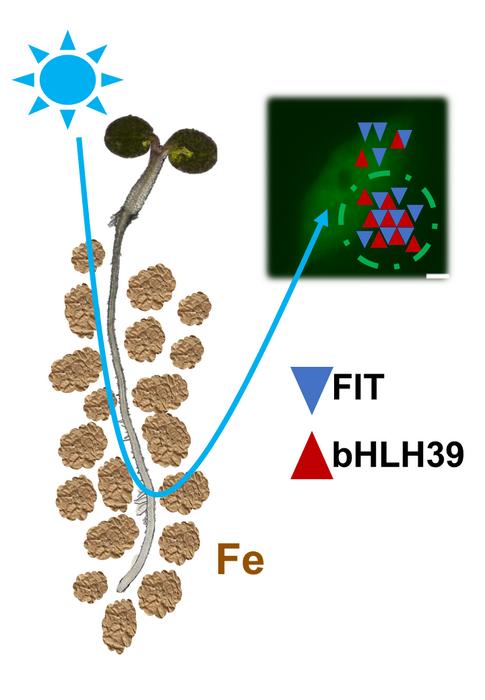Iron is a micronutrient for plants. Biologists from the Institute of Botany at Heinrich Heine University Düsseldorf (HHU) describe in a study, which has now been published in the Journal of Cell Biology, that regulatory proteins for iron uptake behave particularly dynamically in the cell nucleus when the cells are exposed to blue light – an important signal for plant growth. They found that the initially homogeneously distributed proteins relocated together into “biomolecular condensates” in the cell nucleus shortly after this exposure.

Credit: HHU/Ksenia Trofimov, Petra Bauer
Iron is a micronutrient for plants. Biologists from the Institute of Botany at Heinrich Heine University Düsseldorf (HHU) describe in a study, which has now been published in the Journal of Cell Biology, that regulatory proteins for iron uptake behave particularly dynamically in the cell nucleus when the cells are exposed to blue light – an important signal for plant growth. They found that the initially homogeneously distributed proteins relocated together into “biomolecular condensates” in the cell nucleus shortly after this exposure.
Both iron deficiencies and excesses are problematic for plants. They need the micronutrient for photosynthesis and enzymatic reactions. A lack of iron leads to yellowing of the plants and reduced growth, while an excess can result in cell damage. A well-balanced iron uptake must therefore be in place to ensure a healthy plant life.
Once the plant has an iron deficiency, a signalling cascade is activated and more iron is taken up via the roots. Proteins that regulate particular genes (so-called transcription factors) play an important role in this process.
A research team from the Institute of Botany at HHU headed by Professor Dr Petra Bauer has examined the cellular localisation of the transcription factors involved in iron uptake, concentrating in particular on an essential transcription factor within the iron signalling cascade called “FIT”.
To date, very little research has been conducted into where in the nucleus the transcription factors occur in the plant cell. However, knowing this would aid understanding of the function of the protein. Whether the localisation can change is also relevant, as this may be part of a regulatory mechanism that acts on the protein.
The study, which has now appeared in the Journal of Cell Biology, found that FIT is a dynamic protein that can localise in membrane-less sub-compartments – so-called biomolecular condensates – within the cell. The authors consider these sub-compartments regulatory hubs that enable spatially and temporally flexible platforms for signalling and interaction.
The biologists found that FIT specifically accumulates in condensates within the cell nucleus when the plant cells have been exposed to blue light. They examined blue light in particular as it is an important environmental signal for the plant and iron uptake.
The formation of condensates of certain light-regulated proteins has already been described. Biomolecular condensates arise when protein complexes accumulate locally. However, a connection with components relevant for nutritional physiology like FIT was not previously known to exist. It was unclear whether FIT condensates can contribute to the organisation and efficiency of cellular processes. To this end, the researchers in Düsseldorf examined the interactions between FIT and other proteins in nuclear condensates in more detail. They found that not only transcription, but also regulation of the mRNA – i.e. of the sections of genetic material that are read from the DNA to control processes – may take place in the condensates.
“For the first time, I observed accumulations of FIT proteins in the form of condensates during laboratory work on a master’s module project, which posed the simple question of why this is so,” says lead author Dr Ksenia Trofimov (now Krooß). This was the start of a major research project: “When we saw these condensates forming, we barely had any idea of what the function could be as the research topic of condensates was just emerging within the plant field. The original question gave rise first to my master’s work and then my doctoral thesis.”
Professor Bauer adds: “This work has led to a new aspect in plant nutrition. We now need to further explore how these condensates are integrated into the signalling cascades of iron uptake and how environmental cues such as light are able to control iron uptake in a fast and dynamic way.”
The extensive microscopy study was made possible by the Center for Advanced Imaging (for short: CAi), a high-performance, inter-faculty imaging facility at HHU.
Original publication:
Ksenia Trofimov, Regina Gratz, Rumen Ivanov, Yvonne Stahl, Petra Bauer, and Tzvetina Brumbarova, Corresponding Author(s): Petra Bauer, Heinrich Heine University Duesseldorf. FER-LIKE IRON DEFICIENCY-INDUCED TRANSCRIPTION FACTOR (FIT) accumulates in nuclear condensates, Journal of Cell Biology (2024).
DOI: 10.1083/jcb.202311048
Journal
Journal of Cell Biology
DOI
10.1083/jcb.202311048
Article Title
FER-LIKE IRON DEFICIENCY-INDUCED TRANSCRIPTION FACTOR (FIT) accumulates in nuclear condensates
Article Publication Date
23-Feb-2024




